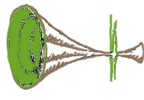The practice of yoga is the gradual cleansing and opening of each chakra. Once these energies’ vortexes are open, the flow of kundalini, or shakti energy, can rise up the central channel and consciousness merges with God. The impression is easily gained that these chakras must be opened sequentially, beginning with the lowest and moving upward. This is not actually stated in any of the ancient texts on yoga. Many people may have one or two chakras already open but have lower ones blocked.
 In Dr. Motoyama’s experience the chakras should be opened in a specific sequence but not starting from the muladhara. He strongly advises the student begin with the ajna, and says, “if the ajna is awakened first, the overpowering and potentially dangerous karmic forces hidden in the lower chakras may be safely controlled.” After awakening the ajna, the yogi moves on to opening the muladhara and then the svadhisthana chakras.
In Dr. Motoyama’s experience the chakras should be opened in a specific sequence but not starting from the muladhara. He strongly advises the student begin with the ajna, and says, “if the ajna is awakened first, the overpowering and potentially dangerous karmic forces hidden in the lower chakras may be safely controlled.” After awakening the ajna, the yogi moves on to opening the muladhara and then the svadhisthana chakras.
Through his clairvoyant visions, Dr. Motoyama reports that chakras are less like wheels and more like cones, with the root of the cone in the spine and the top, open end of the cone on the front surface of the body. He calls the front of the chakra the receptor. The following table summarizes some of the attributes of each of the seven chakras, mostly from Dr. Motoyama’s Theories of the Chakras.
| Chakra | Receptor | Root | Element | Sense | Petals | Bija Mantra |
| Muladhara | Perineum (pelvic floor) | coccyx | Earth | Smell | Four | Lam |
| Svadhisthana | 1~2 inches below navel | 2nd/3rd sacral vertebra | Water | Taste | Six | Vam |
| Manipura | Around the navel | 2nd lumbar | Fire | Sight | Ten | Ram |
| Anahata | Halfway between nipples | 8th thoracic | Air | Touch | Twelve | Yam |
| Visuddha | In the throat | 1st thoracic/C7 | Space | Hearing | Sixteen | Ham |
| Ajna | Between eyebrows | medulla oblongata | – | – | Two | Om |
| Sahasrara | Top of head | – | – | – | One Thousand | – |
There is one major difference between Dr. Motoyama’s view of the function of the chakras and those of most authors on yoga: Dr. Motoyama has determined that the chakras are bridges between the three bodies we each possess. These three bodies are:
- The physical body and its mind: the consciousness associated with the physical.
- The astral or subtle body and its mind: the consciousness associated with emotion. This is the home of prana or Chi. It is interesting to note that Chi obeys physical laws. It weakens over space and time.
- The causal body and its mind: the consciousness associated with wisdom and intellect. This is the home of a higher psychic energy known as “Psi.” It is also interesting to note that physical laws do not bind Psi. It does not weaken over space and time, but like a laser stays powerfully focused wherever it is directed.
Dr. Motoyama tells us that the physical body is yang compared to the yin nature of the astral and causal bodies. It is the chakras that link these bodies together and allow information and energy to flow between them. It is due to this linkage that yogis throughout the ages have been able to perform normally impossible feats. For example, a master buried alive for weeks with no air, food, or water survives because of her ability to transform astral energies into physical energy
Now that we have models of energy (prana), its pathways (nadis), and the main energy centers (chakras), all that is left to explore is the practice of moving the energy. This practice is pranayama.
(Next: Pranayama )
